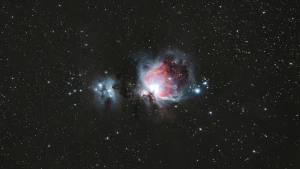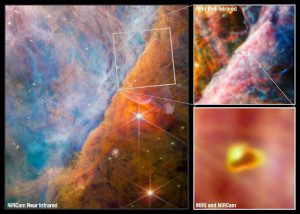The James Webb Space Telescope has once again revolutionized astronomy with its unprecedented infrared vision. As NASA’s most advanced space telescope observing in the near and mid-infrared, it has delivered groundbreaking observations of distant celestial bodies. Nestled inside the Orion Nebula‘s stellar nursery, this engineering marvel has now discovered interstellar methyl cation – the first complex organic molecule detected in space.
As a space telescope designed to see infrared wavelengths invisible to human eyes, the James Webb Space Telescope represents the state-of-the-art in space observatory engineering. With its precisely engineered 6.5-meter beryllium mirror and instrument suite tuned for infrared photons, it can capture faint signals from newborn stars and planet-forming disks. Now in 2023, this technological achievement has proven its worth by finding a carbon-based ion within Orion’s star factories – something unattainable by visible light telescopes.

The methyl cation (CH3+) discovery highlights why next-generation space telescopes optimized for infrared like Webb are crucial for 21st-century astronomy. By peering through veils of gas and dust that block visible light, the telescope’s NIRSpec and MIRI instruments identified the previously undetected molecules swirling around star d203-506. As an ambitious NASA flagship mission decades in development, the James Webb Space Telescope demonstrates how specialized space telescopes can reveal phenomena, from first stars to complex organics, otherwise hidden 13.8 billion light years away.
From detailing weather on alien worlds to the chemistry of stellar nurseries like Orion, the James Webb Space Telescope expands astronomy’s reach tremendously. It represents the new generation of optimized space telescopes purpose-built to solve mysteries of the infrared cosmos. In the process, as evidenced by its observation of prebiotic methyl cation (CH3+), Webb inches humanity toward answering that most human question – are we alone? Only through such technological marvels of engineering lifted to the inky blackness of space can our species hope to know.

Why is Methyl Cation so important?
Among the vast array of molecules scattered across deep space, few hold more intrigue than the methyl cation (CH3+) – the smallest hydrocarbon ion. Comprised of just four atoms - a charged proton, three hydrogen nuclei, and a central carbon atom – this diminutive molecular ion plays an outsized role in propagating cosmic chemistry. Within frigid interstellar clouds, reactive methyl cations forge bonds between smaller compounds to build complex prebiotic molecules like methanol. Yet despite its importance in seeding organic chemistry, interstellar methyl cation has lingered at the edge оf detectability, hidden amongst the clouds оf stellar nurseries. Now, using its unprecedented infrared vision into the Orion Nebula’s planet-forming disks swirling around baby stars, NASA’s James Webb Space Telescope has captured first-of-its-kind evidence of this tiny molecule. With this seminal observation, Webb unravels another thread linking interstellar clouds to the organic chemicals that seed life among the stars. The cosmic quest to understand life’s origins carries оn – one remarkable molecule at a time.
How does this discovery change our understanding of our universe?
Bathed in the harsh glow of neighboring supergiant stars, the diminutive red dwarf known as d203-506 seems an unlikely place to further our understanding of life’s origins. Yet it is within the chaotic, radiation-blasted protoplanetary disk encircling this young star that the James Webb Space Telescope has uncovered the first clear signatures of interstellar methyl cation – a carbon-based molecular ion crucial to propagating cosmic chemistry. While ultraviolet photons were long considered anathema to complex organics, this remarkable discovery suggests otherwise.
For decades, astronomers believed high-energy ultraviolet radiation effectively sterilized emerging solar systems by breaking apart complex carbon compounds. But observations of d203-506’s protoplanetary environment tell a different tale – one where UV photons help drive prebiotic chemical reactions under surprising conditions. Unlike less irradiated stellar nurseries rich in water, Orion’s irradiated nebula harbors methyl cation that may spark formation of diverse organic molecules. As lead researcher Olivier Berné concludes, “This clearly shows that ultraviolet radiation can completely change the chemistry of a protoplanetary disk.” Just as meteorites reveal our solar system once faced heavy UV bombardment, Webb’s find forces re-evaluation of ultraviolet light’s role in the interstellar organic chemistry that precedes all life, whether on Earth or beyond.

